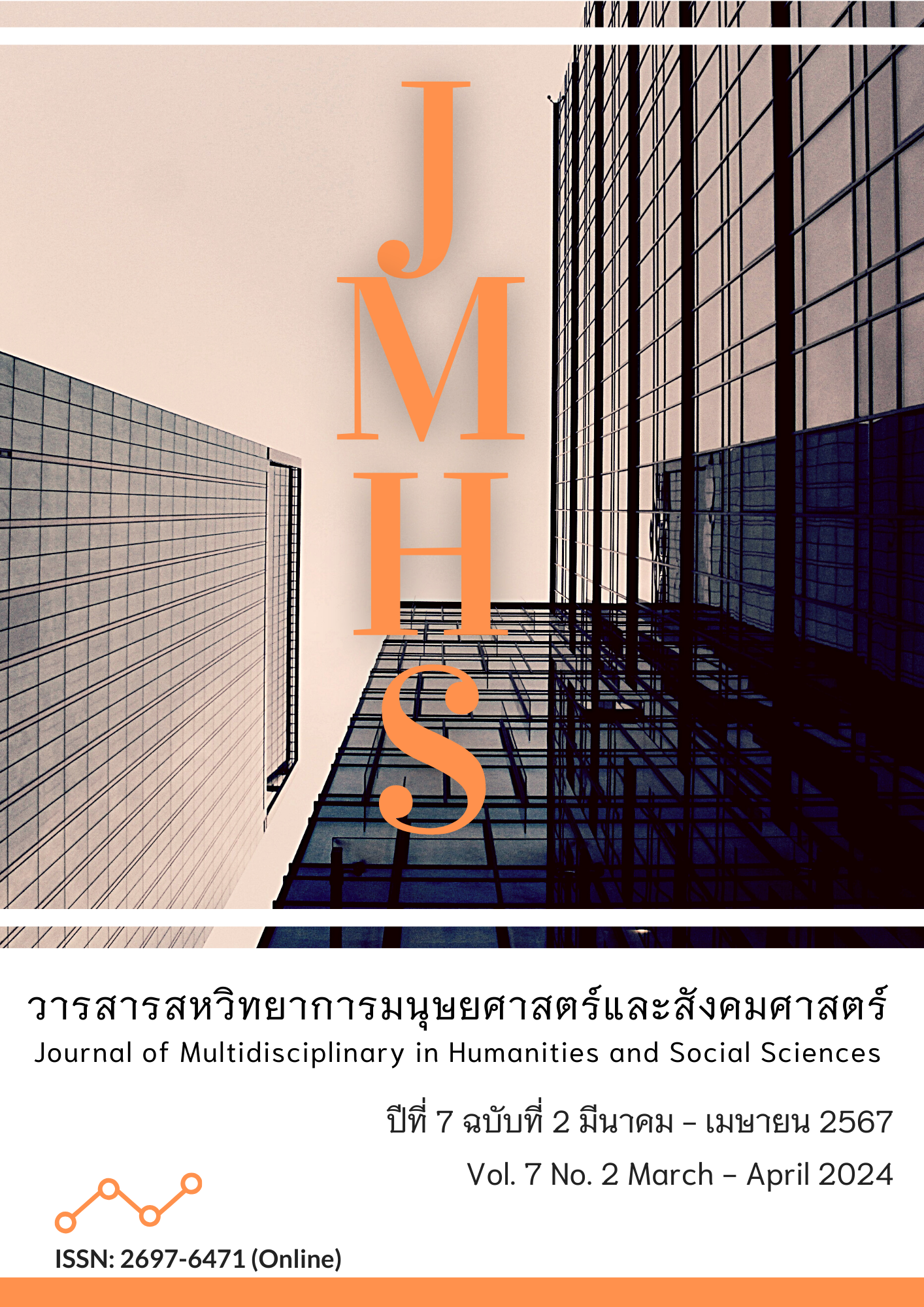The Image of Women in Short Stories of Deuanwad Pimwana
Main Article Content
Abstract
This article aimed to study images of women and the image presentation methods used in 36 short stories by author Deuanwad Pimwana, with a total of 44 female characters. This qualitative research used an image study as a framework. The findings of the research were that images of women in the short stories by Deuanwad Pimwana were divided into three areas. Firstly, the family images appeared as negative images of wives, such as abused wives, abandoned wives, immoral wives, power-obsessed wives, absorbed wives, misleading wives, wives who fall out of love, deceitful wives, attention-seeking wives, and disappointed wives. In contrast to this were other images of women who appeared as positive, compassionate wives, loyal wives, independent wives, and wives who consented to a relationship. Additionally, negative images of children, such as abused children and intolerable children, are used. Secondly, the individual female images appeared as negative images, such as self-indulgent women, power-obsessed women, unrequited-love women, women who want to win, and women with mental health problems; in contrast, other images appeared as positive images of women who have dreams, hopeful women, reliable women, true love-seeking women, desirable women, women of gender diversity, and self-aware women. Thirdly, the social images appeared as negative images of female sex workers, women who resist social values, and women who are dishonest in their professions, but also images that express positive women, such as being a devoted teacher. There were 3 methods used in regard to image presentation methods: direct character presentation, indirect character presentation, and the presentation of comparable characters. Knowledge from this research is the use of image theory to analyze female characters in literature. It makes it possible to look at literature from a more profound perspective, and the study of the image reflects the problems of women in Thai society.
Article Details

This work is licensed under a Creative Commons Attribution-NonCommercial-NoDerivatives 4.0 International License.
Views and opinions appearing in the Journal it is the responsibility of the author of the article, and does not constitute the view and responsibility of the editorial team.
References
กรฎา สุขุม และ สริตา ปัจจุสานนท์. (2565). วิเคราะห์บุคลิกภาพของตัวละครในเรื่องสั้นของเดือนวาด พิมวนา. วารสาร Journal of Buddhist Education and Research, 8(2), 17-29.
เกศราพร ทองพุ่มพฤกษา. (2562). แม่ เมีย และ “สัตว์โลกแสนสวย”: นิยามแห่งความเป็นเพศหญิงในหนังสือนิทานภาพสำหรับเด็ก?.วารสารศาสตร์, 13(1), 29-91.
ชเนตตี ทินนาม และอรวรรณ ปิลันธน์โอวาท. (2554). ผู้หญิงหายไปไหนในวาทกรรมพรหมจารี?: มุมมองจากสื่อ พ.ศ. 2449-2519. วารสารวิทยาการจัดการและสารสนเทศศาสตร์, 6(2), 13-28.
เดือนวาด พิมวนา. (2538). หนังสือเล่มสอง. กรุงเทพฯ: สามัญชน.
เดือนวาด พิมวนา. (2549). สัมพันธภาพ. กรุงเทพฯ: สามัญชน.
เดือนวาด พิมวนา. (2550). ทุกข์หฤหรรษ์. กรุงเทพฯ: สามัญชน.
เดือนวาด พิมวนา. (2557). ฝันแห้งและเรื่องอื่น ๆ. กรุงเทพฯ: สามัญชน.
ทัศนีย์ ทานตวณิช. (2558). ภาพลักษณ์ของสมเด็จพระเทพรัตนราชสุดาฯ สยามบรมราชกุมารีในบทเพลงเทิดพระเกียรติ. ใน เอกสารประกอบการนำเสนอบทความวิชาการวันบูรพาภาษาไทย: ภาษาและวรรณกรรมอาเซียน (หน้า 1-21). ชลบุรี: มหาวิทยาลัยบูรพา.
ธนกร พฤกษชาติถาวร. (2564). ศึกษาภาพลักษณ์นางงามไทยที่สะท้อนผ่านการตอบคําถามบนเวทีมิสยูนิเวิร์สไทยแลนด์. วารสารนิเทศสยามปริทัศน์, 20(2), 230-242.
นริศรา เกตุวัลห์. (2538). การศึกษาวิเคราะห์ภาพลักษณ์ของผู้หญิงในนวนิยายของสุวัฒน์ วรดิลก ในช่วง พ.ศ. 2492- พ.ศ. 2528 (ปริญญานิพนธ์การศึกษามหาบัณฑิต). มหาวิทยาลัยศรีนครินทรวิโรฒ.
ปรียาดา กุลรินทร์ และ นราวัลย์ พูลพิพัฒน์. (2561). ศึกษาการสร้างภาพลักษณ์สตรีในนวนิยายไทยที่ได้รับรางวัลใน พ.ศ. 2550-2559. วารสารพิฆเนศวร์สาร, 14(1), 123-133.
ปิยะธิดา เกตุชาติ และวรรณพร พงษ์เพ็ง. (2560). ศึกษาภาพแทนผู้หญิงในวรรณกรรมรักโรแมนติกสำหรับผู้ใหญ่ของสำนักพิมพ์ไลต์ ออฟ เลิฟ. วารสารภาษา ศาสนา และวัฒนธรรม, 6(2), 20-36.
พัชราวลี จินนิกร. (2559). การศึกษาภาพลักษณ์ของตัวละครหญิงในวรรณกรรมเรื่องผู้ชนะสิบทิศ(วิทยานิพนธ์ศิลปศาสตรมหาบัณฑิต). มหาวิทยาลัยบูรพา.
รื่นฤทัย สัจจพันธุ์. (2546). ช่างสำราญ...เรื่องราวของสังคมไทยที่ไม่แล้งน้ำใจและความเอื้ออาทร. ใน สุวรรณา เกรียงไกรเพ็ชร์ (บรรณาธิการ), ลายลักษณ์แห่งการวิจารณ์: รวมบทวิจารณ์ร่วมสมัย เล่ม 2 (หน้า 55-61). กรุงเทพฯ: คมบาง.
รื่นฤทัย สัจจพันธุ์. (2547). อำนาจ...ภาพลวงตาของคุณธรรมและความรัก. ใน สุวรรณา เกรียงไกรเพ็ชร์ (บรรณาธิการ), มองข้ามบ่านักเขียน: เรื่องสั้นไทยในทัศนะนักวิจารณ์ (หน้า 441-446). กรุงเทพฯ: ชมนาด.
วนิดา บำรุงไทย. (2544). ศาสตร์และศิลป์แห่งนวนิยาย. กรุงเทพฯ: สุวีริยาสาส์น.
วิทย์ ศิวะศริยานนท์. (2544). วรรณคดีและวรรณคดีวิจารณ์. กรุงเทพฯ: ธรรมชาติ.
สมบัติ สมศรีพลอย และ ธิดาวัฒน์ สุพุทธิกุล. (2563). ศึกษาภาพลักษณ์และบทบาทผู้หญิงจากเพลงลูกทุ่งในปี พ.ศ. 2557–2561. วารสารสารสนเทศ, 19(1), 139-148.
สรณัฐ ไตลังคะ. (2560). ศาสตร์และศิลป์แห่งการเล่าเรื่อง. กรุงเทพฯ: มหาวิทยาลัยเกษตรศาสตร์.
สริยกานต์ ยี่เก็งเอี่ยม. (2564). ศึกษากลวิธีทางวรรณศิลป์และภาพความเป็นอื่นในกวีนิพนธ์ของอังคาร จันทาทิพย์. วารสารมนุษยศาสตร์และสังคมศาสตร์ มหาวิทยาลัยราชภัฏอุบลราชธานี, 12(2), 225-241.
สัจภูมิ ละออ. (2546). 25 ปีซีไรต์. กรุงเทพฯ: สยามอินเตอร์บุ๊คส์.
เสนาะ เจริญพร และ นพพร ประชากุล. (2548). ผู้หญิงกับสังคมในวรรณกรรมไทยยุคฟองสบู่. กรุงเทพฯ: มติชน.
อรทัย เพียยุระ. (2561). วรรณกรรมกับเพศภาวะ. (พิมพ์ครั้งที่ 2). ขอนแก่น: ขอนแก่นการพิมพ์.
อาทิตย์ ศรีจันทร์. (29 ตุลาคม 2563). “ในฝันอันเหลือจะกล่าว” ของเดือนวาด พิมวนา กับความจริงอันเหลือจะกล่าวได้เช่นกัน. สืบค้นเมื่อ 18 มีนาคม 2565, จาก https://www.the101.world/duanwad-pimwana-novel/
อัญมณี ภักดีมวลชน และ วริษฐา อุเทศนันท์. (2562). ภาพตัวแทนของโสเภณีในละครโทรทัศน์. วารสารการสื่อสาร มหาวิทยาลัยราชภัฏเชียงราย, 2(3), 26-50.
Kotler, P. (2000). Marketing management. New Jersey: Prentice-Hall.
Boorstin, D. (1973). The image: a guide to pseudo-events in America. New York: Atheneum.
Boulding, K. (1975). The Image: Knowledge in life and Society. Michigan: The University of Machigan.


